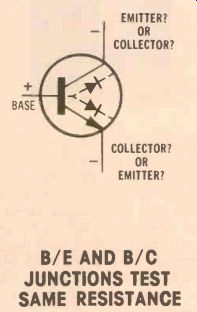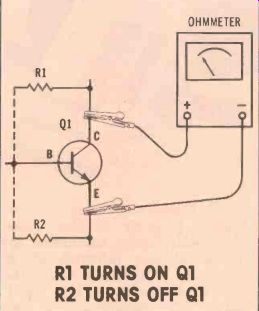By Wayne Lemons, CET
Most technicians know how to use an ohmmeter for quick tests of transistors by measuring the for ward and reversed resistances of base/collector, base/emitter and emitter/collector as if they were diodes. Of course the ohmmeter must have sufficient voltage to turn-on silicon transistors, and the polarity of the meter leads must be known. (Many portable VOMs have positive voltage at the black lead and negative at the red during resistance tests.) Although such tests can locate obvious or severe defects, they have serious limitations. If all junction resistances are normal, the base lead has been identified (see Figure 1). However, both emitter and collector measure nearly the same relative to the base. Some other test must be used to determine the collector.


------ B/E AND B/C JUNCTIONS TEST SAME RESISTANCE
Amplification
A simple series of additional steps can identify the collector lead by forcing the transistor to amplify.
With the ohmmeter set for the X1000 range, go through these steps:
- Connect the ohmmeter between collector and emitter leads (Figure 2).
- Dampen a finger.
- Touch the wet finger between base and one of the other leads. Notice the resistance reading.
- Touch the wet finger between base and the other transistor lead. Compare this reading with the former one.
The finger resistance that produced the lowest reading is between base and collector. If both readings are about the same, perhaps the meter polarity was not right for the transistor polarity. Reverse the test leads at the transistor and repeat the four steps.
If no significant difference is obtained with either polarity, the transistor probably cannot amplify, and it should be replaced.
Behind the test is the principle that a suitable resistance between base and collector will supply forward bias when a voltage of correct polarity is applied to the collector. Of course, many transistors will have a small amount of collector/emitter current when the polarity is reversed. But of the four possible connections of bias resistor and C/E polarity, only one will produce maximum C/E conduction.
Better consistency of results can be obtained if a 24K resistor is used instead of the wet finger. However, the benefit of emergency measurements is lost. For more accuracy it's always advisable to use a good type of transistor tester.
Also see: Reports from the test lab